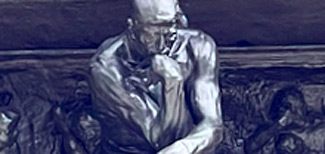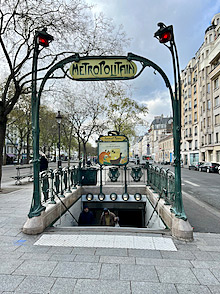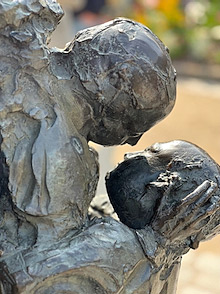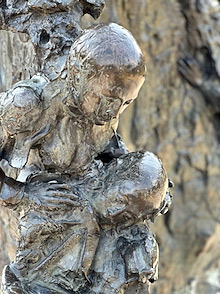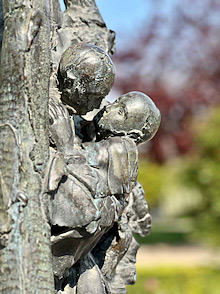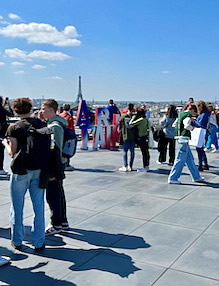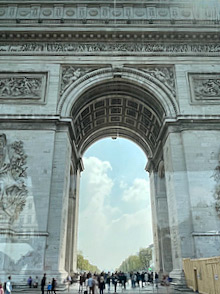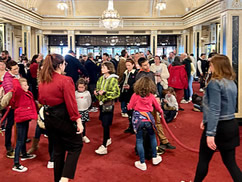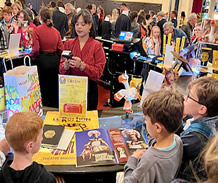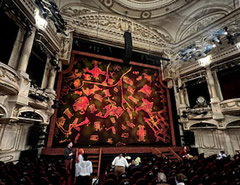| |
|
There are landmarks everyone must check out in Paris, of course. There is the Eiffel Tower. There is the Arc de Triomphe. There’s the Cathedral Notre Dame.
| |
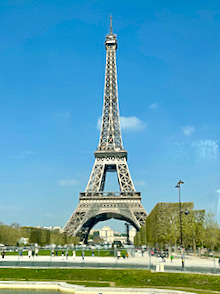 |
|
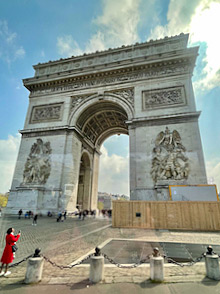 |
|
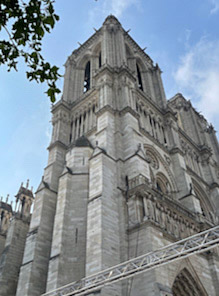 |
|
| |
Eiffel Tower |
|
Arc de Triomphe |
|
Notre Dame |
|
But there is so much more - and we wanted to sample and share some things we’d heard about but never had a chance to see in person. So here are some wonderful spots you might consider seeking out if you visit the capital city of France.
Paris is known for its open-air markets. We couldn’t visit them all, but we spent one morning strolling one of the largest, the Marché Bastille. It sits in the shadow of the monument to the Bastille, the prison where the French Revolution began on July 14, 1789 - yes, the reason that day is now known as Bastille Day. The former fortress-turned-prison was demolished, but the monument marks the spot and a station on the legendary Paris Underground serves the square.
| |
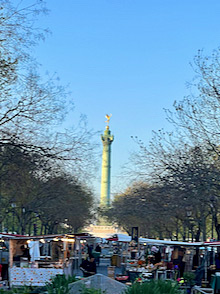 |
|
|
|
| |
The monument where the Bastille stood |
|
Paris has famous Art Nouveau underground entrances. |
|
Now, twice a week - Thursdays and Sundays - the Boulevard Richard-Lenoir at the foot of the monument is home to row upon row of open-air stalls. Nearly a hundred of them. There you will find temptations from produce to meats, flowers and plants, to scarfs and apparel.
| |
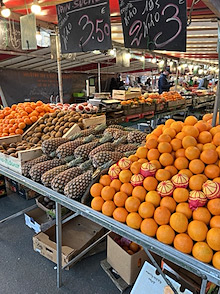 |
|
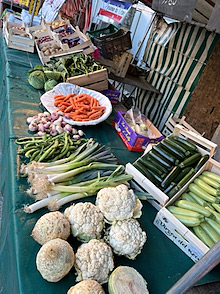 |
|
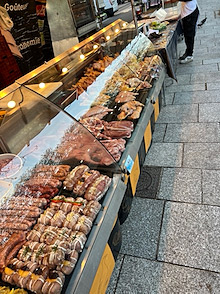 |
|
| |
Marche Bastille fruit stall |
|
Marche Bastille produce stall |
|
Marche Bastille meat stall |
|
| |
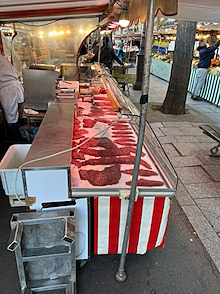 |
|
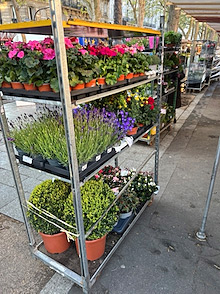 |
|
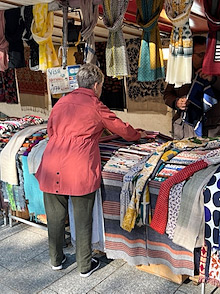 |
|
| |
Meat stall |
|
Flower stall |
|
Shawl stall |
|
Almost every visitor to Paris seems to make the pilgrimage to the Louvre, if only to be part of a crowd looking at the tiny Mona Lisa. But to get truly up-close and personal with great art, nothing quite beats the Musée Rodin. The museum has two locations: the Hôtel Biron and surrounding grounds in central Paris, as well as Rodin's old home, just outside Paris at the Villa des Brillants at Meudon, Hauts-de-Seine. The museum actually in Paris is enough to make a day special. The Hôtel Biron was a former mansion and then a religious boarding school for girls. It was here that August Rodin had a studio. He eventually agreed to donate all his works to the state if they would make this a museum and allow him to live and work there for free for the rest of his life.
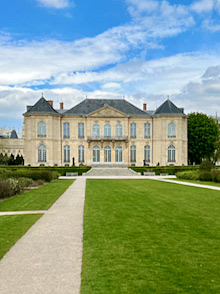
The Hôtel Biron, site of the Musée Rodin
The works of Rodin on display here include world-famous sculptures such as The Gates of Hell’s scenes from Dante’s Inferno which feature The Thinker, and The Three Shades (souls of the damned).
| |
 |
|
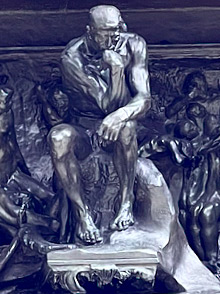 |
|
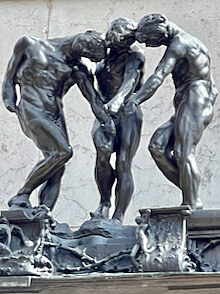 |
|
| |
Rodin’s Gates of Hell |
|
The Thinker |
|
The Three Shades |
|
The opportunity to get right up next to the incredible Burghers of Calais lets you examine the facial expressions of the six men who gave their lives for their city in 1346 during the Hundred Years War.
| |
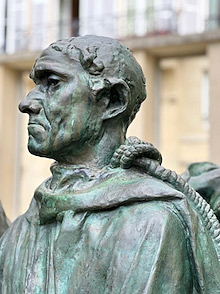 |
|
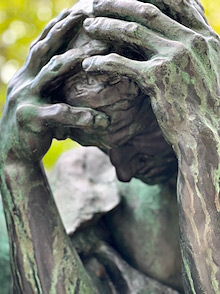 |
|
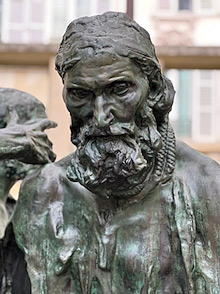 |
|
| |
A Stoic Burgher |
|
A distraught Burgher |
|
A determined Burgher |
|
It is reported that 700,000 people visit the Musée Rodin each year. I suspect far fewer head to the Square René-Viviani on the edge of the Seine opposite the Cathedral Notre Dame. There is sculpture there to please anyone who finds Rodin’s work thrilling. The piece by George Jeanclos, was commissioned for this park in 1995. It is actually a fountain, but no water was running at the time of our visit. The three-sided structure is studded with evocative busts of Jewish children of the neighborhood who died in Nazi deportations during World War II.
| |
Jewish children - victims of the Holocaust |
|
Not all the great art in Paris is in museums or parks.There is a shopping mall that draws visitors from far and near, not for the shops but for its stained glass. The Galleries Lafayette is a huge department store whose main building dates to 1912. It features a grand stained glass and steel dome by one of the principal proponents of Art Nouveau, glassworker Jacques Grüber. The dome seems to hover above the open atrium which is circled by gilded ironwork balconies designed by Louis Majorelle. The dome itself was thankfully taken apart and stored during the bombing of World War II, but has been fully restored to its original beauty.
| |
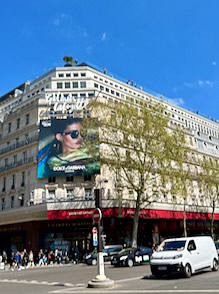 |
|
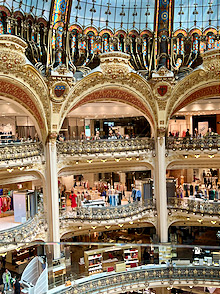 |
|
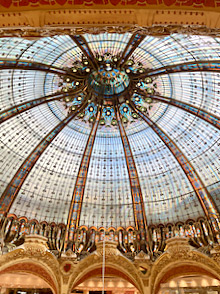 |
|
| |
The Galleries Lafayette... |
|
its gilded balconies... |
|
and dome |
|
Tourists and Parisians who visit the dome also go to the roof of the building for spectacular views over the rooftops of Pairs. The Eiffel Tower - well - towers on the horizon.
| |
|
|
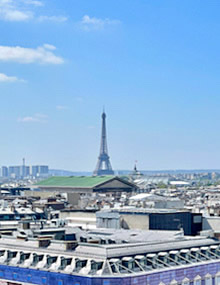 |
|
| |
Roof of the Galleries Lafayette |
|
Eiffel Tower on the horizon |
|
| |
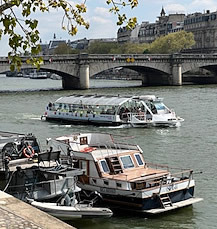 |
|
Another way to view this lovely city is from the water as the Seine separates the right bank or “rive droite” on the north side from the left bank or “rive gauche” on the south side. We boarded a “Batobus” - a low, glass-covered trimaran shuttle - to get this view as we sailed from one end of the city to the other. |
|
| |
The Batobus on the River Seine |
|
|
|
| |
There are 37 bridges that cross the river, each a reflection of the architectural tastes of the time when it was built. One of the bridges, the Pont de l’Alma, features a statue of a French infantryman (known as a Zouave) by sculptor Georges Diebolt. When the Seine floods, the Zouave may be more than half submerged. Indeed, locals use this statue as an informal flood gage. Fortunately, the water level was nowhere near flood stage as we passed by. |
|
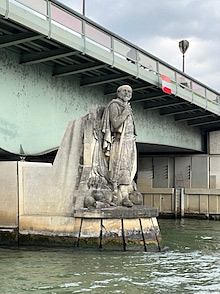 |
|
| |
|
|
The Pont de l’Alma’s Zouave |
|
| |
 |
|
The Pont au Change, on the other hand, bears a simple emblem of Napoleon because this bridge was built between 1858 and 1860 while Napoleon III was the monarch. The name of the bridge, however, dates back to the 12th century when money changers and goldsmiths had booths or even shops on the bridge connecting the Île de la Cité to the Rive Droite. If you have seen the musical Les Miserables you will find the location of this bridge of interest, for it was from the Pont au Change that Inspector Javert jumped to his death in one of the most notable stagings of the show. |
|
| |
Pont au Change |
|
|
|
| |
The most ornate of the bridges we saw would have to be Pont Alexandre III, built at the end of the nineteenth century when the Beaux-Arts style was in full swing. So, who was Alexandre III? There was no French sovereign by that name. It was named for a Tsar of Russia. The cornerstone for this bridge was laid by his son, Nicholas II - the last Tsar of Russia who was forced to abdicate his throne and then was assassinated along with his entire family by the Bolsheviks. Towering over the counterbalancing bases on the four corners of the bridge are four bronze statues, fully gilded, representing mythological Greek entities with associations of science, arts, commerce and industry, each posed with an equally gilded Pegasus. |
|
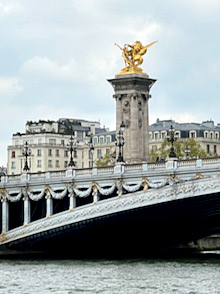 |
|
| |
|
|
Pont de Alexandre III |
|
| |
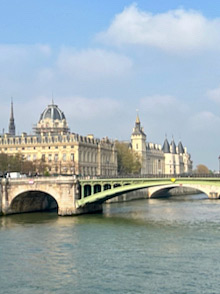 |
|
Looking somewhat more industrial is the Pont Notre-Dame, the latest construction at this spot, where a bridge of some sort has existed since Roman times, although some think there was a bridge here built by Celtic tribes before Julius Ceasar’s army arrived in 52 BC. This structure, with stone at each bank, has two metal spans allowing safer river navigation than its predecessor which had five shorter spans each with less room for boats to clear. That one had been the scene of so many accidents on the water that it had earned the nickname Pont du Diable - or The Devil’s Bridge. |
|
| |
Pont Notre-Dame
(The Devil’s Bridge) |
|
|
|
| |
Finally, there is the Pont d’Iéna joining the Trocadero gardens to the gardens of the Eiffel Tower. I’m not sure that many tourists on boats such as the Batobus spend much time looking at the bridge itself because the view of the Eiffel Tower from the water here is captivating. If you can tear your eyes away from the tower, however, it is worth looking at the steps down from the roadway where the tower stands to the walkway at river level. These are the steps Roger Moore as James Bond drove a Renault down in the famous chase scene in the film A View to a Kill. Locals now call them the Renault Stairs. |
|
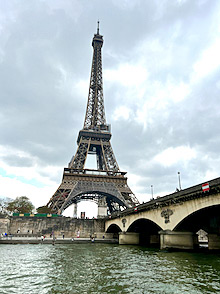 |
|
| |
|
|
Pont d’Iéna |
|
| |
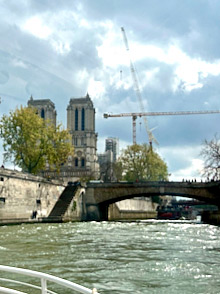 |
|
At one point, the Seine separates into two channels and flows on both sides of the Île Saint-Louis and the Île de la Cité. The narrower channels require shorter bridges but the views are spectacular. I doubt many tourists pay any attention at all to the small, as its name implies, Petit Pont. That is because the Cathedral of Notre Dame rises beyond it and, well, who is going to look at this simple structure when there’s the Cathedral to look at even now when the skyline features cranes as the Cathedral is being restored after the disastrous fire of 2019? |
|
| |
Petit Pont |
|
|
|
| |
We left the Batobus at a stop on the rive gauche to stroll down to the Rue Jacob in search of a touch of American history in this French capital. There we found a fairly unremarkable building at number 52. This is where Ben Franklin, as a representative of the American colonies, lived during the negotiations leading to the Treaty of Paris in 1783. It was that treaty with Great Britain that ended the Revolutionary War and gained the United States of America recognition as a sovereign nation. The treaty itself was signed just a few doors down the street. Now the neighborhood is home to shops and art galleries as well as residences. |
|
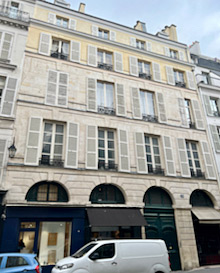 |
|
| |
|
|
Ben Franklin’s home at
52 Rue Jacob |
|
| |
|
|
Another touch of American history I had hoped to track down escaped my grasp. I wanted to find the automotive supply shop on the Avenue de la Grande Armée where George Gershwin purchased the taxi horns he used for the memorable sound in his An American in Paris. I searched histories and sought out experts, but could not come up with the actual location. I had to content myself with the thought “it was down there somewhere” when I looked through the Arch de Triumph down that grand avenue. |
|
| |
The Avenue de la Grande Armée viewed through the Arc de Triomphe |
|
|
|
| |
Another fascination for me, because both my wife and I worked for members of the United States House of Representatives, is to seek out the national parliaments of the countries we visit. We found the seat of the National Assembly of the French Parliament in the Palais Bourbon. We were struck by the image of the statue of Law (or La Loi) by Jean-Jacques Feurchère, which dominates the square that bears the name Place do Palais-Bourbon. |
|
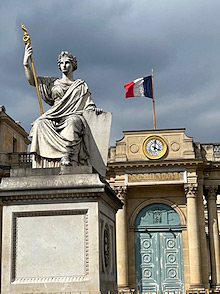 |
|
| |
|
|
The sculpture La Loi (The Law) before the Palais Bourbon |
|
We also love to sample theatrical offerings during our travels - and here was a grand opportunity to catch a Broadway show we had seen many times in English. That way, the language barrier would not be too high since we already knew the story. The show? The Disney production of the Tim Rice and Elton John musical The Lion King which has been going strong in New York ever since its opening in 1997. It has racked up over 10,000 performances on Broadway with reported box office receipts of over a billion dollars, while multiple tours and “sit down” productions including those in London, Hamburg, The Hague, Madrid, Basel, Switzerland and here in Paris have had great success as well. Before my retirement as a theater critic, I had reviewed the show multiple times. Here in Paris it was Disney’s Le Roi Lion.
The audience for the matinee we attended was filled with excited children and their parents. The kids made a bee line for the merchandise counter and then entered the lovely auditorium where the famous show curtain featured African designs. Then, of course, the lights went down and the character of Rafiki summoned the animals to Pride Rock. The parade featuring Julie Taymor’s amazing costumes and puppets always astonishes audiences, and when the elephants lumbered down the aisles the magic had captured everyone—ourselves included.
| |
Kids and Parents arrive for Disney’s Le Roi Lion. |
|
As interested as we were in the show itself, I was also fascinated by the history of the theater in which it played. The 1,600-seat Théâtre Mogador dates to World War I. When it opened in April of 1919, Paris was hosting the peace conference at the Château de Versailles where U.S. President Woodrow Wilson was negotiating the treaty Germany would be forced to sign. Wilson was a big fan of theater. In fact, he attended Jerome Kern’s Very Good Eddie the night Congress gave him the declaration of war in 1917. So it was not surprising to learn that he attended the opening performance of this theater in April of 1919. What I found additionally intriguing was a report that another President of the United States was in attendance that night—well, a future president. It is said that with Wilson that night was Franklin Delano Roosevelt, Wilson’s Assistant Secretary of the Navy during the war. As I took my seat I wondered exactly where the two former U.S. presidents had been seated. It took the arrival of Rafiki’s call to Pride Rock to draw me out of that reverie.
| |
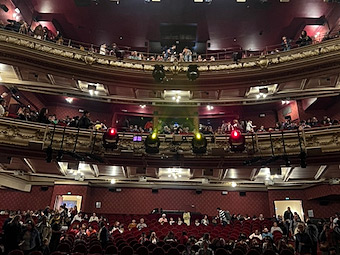 |
|
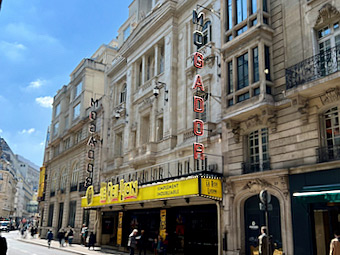 |
|
There is a lyric in the opening of The Lion King in English which I assume is well translated into French for Le Roi Lion and which can be applied to the city of Paris as well as to the scene at Pride Rock:
“There’s more to see than can ever be seen.
More to do than can ever be done.
There’s far too much to take in here.
More to find than can ever be found.”
Lyricist Tim Rice got that right!
ABOUT THE AUTHOR
| |
Brad Hathaway retired to live with his wife on a houseboat in Sausalito, California, after nearly two decades covering theater in Washington, D.C., on Broadway, and nationwide. He is the vice-chair of the American Theatre Critics Association’s Executive Committee. |
|
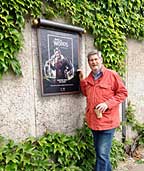 |
|
|
|
|
